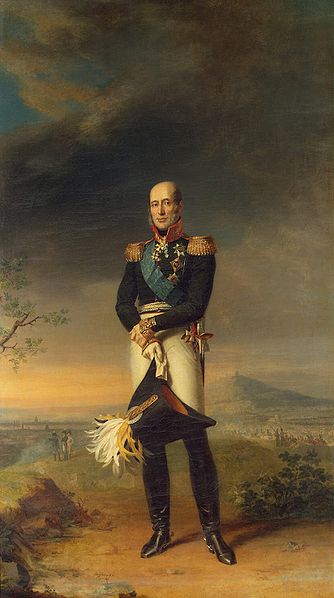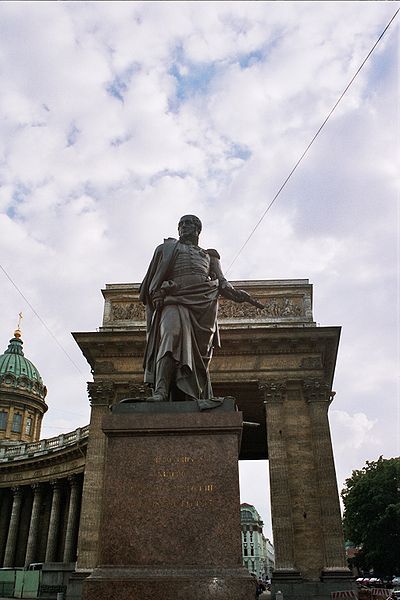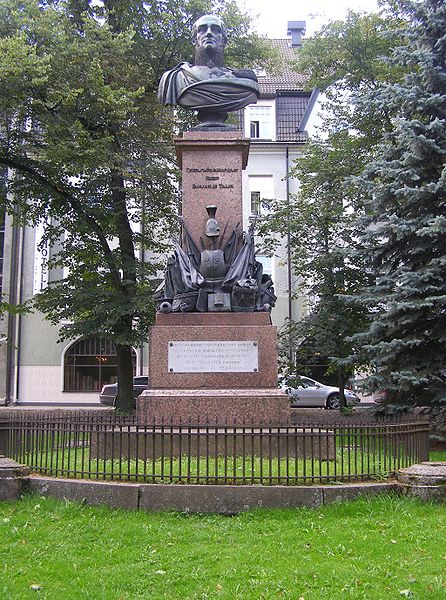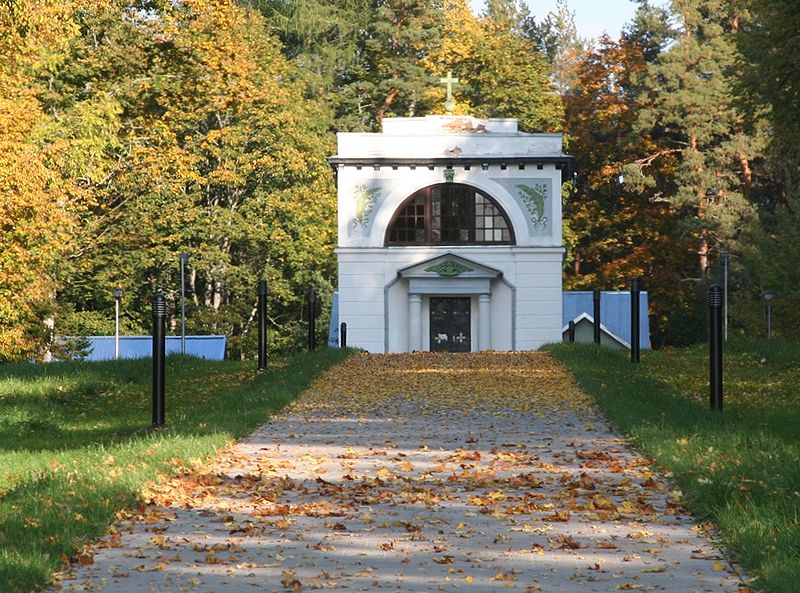<Back to Index>
- Astronomer Johannes Kepler, 1571
- Painter Thomas Fearnley, 1802
- Field Marshal of Russia Michael Andreas Barclay de Tolly, 1761
PAGE SPONSOR


Prince Michael Andreas Barclay de Tolly (27 December [O.S. 16 December] 1761 – 26 May [O.S. 14 May] 1818), known in Russia as Mikhail Bogdanovich Barklay-de-Tolli (Cyrillic: Михаи́л Богда́нович Баркла́й-де-То́лли), was a Russian Field Marshal and Minister of War during Napoleon's invasion of Russia in 1812 and subsequent campaigns of the Russian army in Europe.
Barclay de Tolly, a member of the Scottish Clan Barclay, was born in Pamūšis, Duchy of Courland and Semigallia (in present-day Šiauliai County, Lithuania) and raised in Livonia, then a part of the Russian Empire, and currently divided between Estonia and Latvia. The commonly accepted birth date of 27 December 1761 is the actual day of his baptism in the Lutheran church of the town Žeimelis. He was a German-speaking descendant of a Scottish family which had settled in Livonia in the 17th century. His grandfather served as the mayor of Riga, his father Bogdan Barclay de Tolly was admitted into the ranks of Russian nobility, and the future Field Marshal entered the Imperial Russian Army at an early age. De Tolly was a member of the Akademie gemeinnütziger Wissenschaften. Young Barclay was enlisted in the Pskov Carabineer Regiment on 13 May 1767, and achieved the rank of a cornet by May 1778. In 1788 – 1789 Barclay served against the Turks, distinguishing himself in the taking of Ochakov and Akkerman. In 1790 he operated against the Swedes and, four years later, he fought against the Poles. He was a lieutenant colonel by 1794 after serving as Aide-de-camp to various senior officers in several campaigns. In that year he was appointed commander of the Estland jaeger Corps, and three years later commander of the 4th jaeger Regiment, becoming its chief in 1799, soon after being promoted to General Major for his service in the Polish Campaign of 1794. In the war of 1806 against Napoleon, Barclay took a distinguished part in the Battle of Pultusk (December 1806) and was wounded at the Battle of Eylau (7 February 1807), where his conduct won him promotion to the rank of lieutenant-general. After a period of convalescence, Barclay returned to the army and in 1808 commanded operations against the Swedes during the Finnish War. In 1809 he won a European reputation by a rapid and daring march over the frozen Gulf of Bothnia, which allowed him to surprise the enemy and seize Umeå in Sweden. For this exploit, immortalized by the Russian poet Baratynsky, he was made Full General and Governor-General of Finland. A year later, he became Minister of War, retaining the post until 1813. During
Napoleon's Invasion of Russia in 1812 Barclay assumed the supreme
command of the 1st Army of the West, the largest of the Russian armies
facing Napoleon. He proposed the now famous scorched earth tactic of drawing the enemy deep into one's own territory and retreated to the village of Tsaryovo-Zaimishche between Moscow and Smolensk. Nevertheless,
the Russians keenly opposed the appointment of a foreigner as
commander-in-chief. His rivals spread rumors of him being Napoleon's
agent, and the populace condemned him as a coward. Barclay was forced
by his subordinates and the Tsar to engage Napoleon at Smolensk (17
– 18 August 1812). Napoleon forced Barclay to retreat when he
threatened Barclay's only escape route. After losing the Holy City of
Smolensk, the outcry of officers and civilians grew to a point where
the Tsar could no longer ignore it. Against his better judgment he
appointed Kutuzov,
who had suffered a defeat at Napoleon's hands at Austerlitz, as the
over-all commander of the Russian Forces. Barclay remained General of
the 1st Army of the West. Barclay commanded the right flank at the Battle of Borodino (7 September 1812) with great valor and presence of mind and during the celebrated council at Fili advised
Kutuzov to surrender unfortified Moscow to the enemy. His illness made
itself known at that time and he was forced to leave the army soon
afterwards. After
Napoleon was driven from Russia, the eventual success of Barclay's
tactics made him a romantic hero, misunderstood by his contemporaries
and rejected by the court. His popularity soared, and his honour was
restored by the tsar.
Barclay was re-employed in the field and took part in the campaign in Germany. After Kutuzov's death, he once again became commander-in-chief of the Russian forces at the Battle of Bautzen (21 May 1813), and in this capacity he served at Dresden (26 – 27 August 1813), Kulm (29 – 30 August 1813) and Leipzig (16
– 19 October 1813). In the latter battle he commanded a central part of
the Allied forces so effectively that the tsar bestowed upon him the
title of count. Barclay took part in the invasion of France in 1814 and commanded the taking of Paris, receiving the baton of a Field Marshal in
reward. In 1815 he again served as commander-in-chief of the Russian
army which invaded France, and was created Prince at the close of the
war. As his health grew worse, he left the military and settled down in his Jõgeveste manor (German exonym: Beckhof, Polish: Tepelshof) (nowadays Southern Estonia). Barclay de Tolly died at Insterburg (Chernyakhovsk), East Prussia,
on 26 May 1818 (14 May, Old Style) on his way from his Livonian manor
to Germany, where he wanted to renew his health. His and his wife
Helene Auguste Eleonore von Smitten's remains were embalmed and put
into the mausoleum built to a design by Apollon Shchedrin and Vasily Demut-Malinovsky in 1832 in Jõgeveste (in Helme, Estonia). A grand statue of him was erected in front of the Kazan Cathedral in St Petersburg on behest of Emperor Nicholas I. There are also a modern statue in Riga, a full size bronze mounted statue by Vladimir Surovtsev in Chernyakhovsk, a bust monument in Tartu, and the so-called "Barclay's leaning house" in Tartu (which was acquired by his widow after his death). After extinction of the Barclay de Tolly princely line with his son Magnus on 29 October 1871 (17 October, Old Style), Alexander II allowed the field marshal's sister's grandson through female lineage, Alexander
von Weymarn, to assume the title of Prince Barclay de Tolly-Weymarn on
12 June 1872 (31 May, Old Style).
The
Nesvizhskiy 4th Grenadier regiment (the General-Field Marshal Prince
Barklay-de-Tolli, Mikhail Bogdanovich's) was named for the Prince in
1880s.

